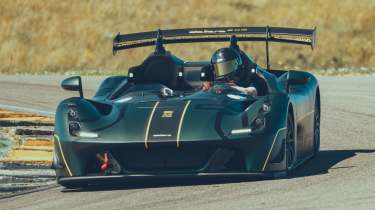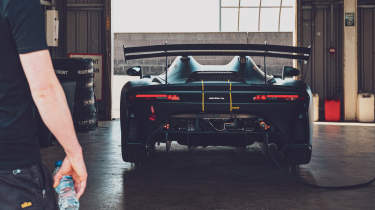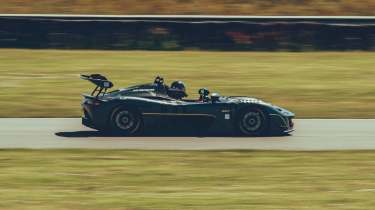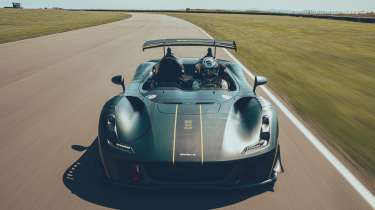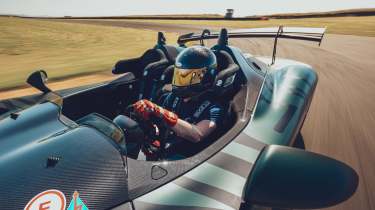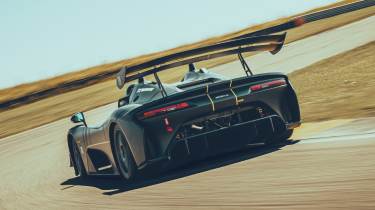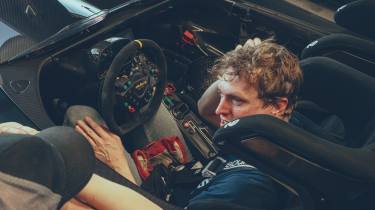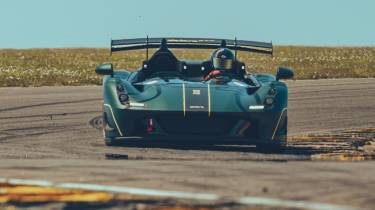Dallara EXP 2025 review – the Stradale's track attack cousin tested against the clock
The Dallara EXP is a Stradale taken to extremes in the name of track performance. We push it to the limit on track against the stopwatch
Wait… wait… past the point where in a supercar you’d already have been hard on the brakes. Every fibre of muscle in your foot is straining, desperate to go for the pedal. Mind over matter… wait a little longer… now! Mash the pedal with all the force your leg can muster, feel your body become a dead weight against the six-point harness, blend out of the brake and turn the wheel.
The Dallara EXP’s carbon splitter darts for the apex, the inside front slick kisses the kerb and you’re away to the next corner. And all of the above took place in a few fractions of a second. It’s the kind of braking and cornering performance that takes some mental adjustment, and the hallmark of a serious racing car. But the Dallara EXP is not a racing car. Well… it is, and it isn’t.
You might remember the Dallara Stradale, driven by Jethro Bovingdon on track in evo 250 and on the road in issue 267. The one and until now only car to bear the name of 88-year-old Giampaolo Dallara – a man with a slightly more remarkable than average CV in automotive engineering, most famously including the Lamborghini Miura when he was aged just 28. His eponymous company currently makes the chassis for the entire IndyCar, Formula 2 and F3 grids, plus for BMW, Cadillac and, soon, McLaren’s Le Mans cars. It also designed the current NASCAR Cup Series car. And has played a key role in numerous famous road cars for marques including Alfa Romeo, Bugatti and Maserati. And no doubt a few others it can’t talk about.
The Stradale is a neatly compact, mid-engined sports car with artful carbonfibre construction and aerodynamic performance at its heart, beautiful details and a focus on track driving – though, as Jethro explored in evo 267, it’s a uniquely thrilling experience on the road, too.
The Dallara EXP is a track-only, non-road-legal version of the Stradale. (Which, logically, would make it a Dallara Pista.) Its unique aerodynamic measures give it even more downforce than the already sticky Stradale, and whilst it’s powered by the same 2.3-litre turbo in-line four from Ford, peak horsepower and torque have been increased to 493bhp and 516lb ft respectively, from 394bhp and 369lb ft in the Stradale. Its double-wishbone suspension is equipped with three-way adjustable dampers and adjustable anti-roll bars.
Given that the Stradale is already a formidably capable machine on track, the prospect of a dedicated circuit version, drawing from Dallara’s bottomless well of motorsport engineering experience, is quite an enticing one. Especially as we’re at the beautiful Anglesey Circuit, where evo records its leaderboard lap times.
It’s a timely moment to test the car, as both the Stradale and EXP have been given a package of ‘Evo’ updates for 2025, and there is now an official Dallara Stradale UK sales and servicing agent. They’ve brought both the new EXP and a pre-update Stradale along for us. The latter is here for context, to compare and contrast with the EXP – a kind of moving spot-the-difference picture.
Our focus is the EXP because, although it was revealed back in 2021, this is its first media test. It makes quite an impression even before you swing a leg over the doorless body. As an object, it’s a lovely thing to behold. While in many ways it’s akin to a racing car, with built-in air jacks, fire extinguishers, tow straps and all the rest, it’s a bit of an oggetto d’arte too. Even the architectural-looking roll-over protection hoops have an aesthetic slant, and the carbonfibre is beautifully finished. There’s plenty of that: the car is built around a carbon monocoque (it’s what Dallara does, after all) and everything from bodywork to dashboard to passenger kickplate and beyond is crafted from the stuff, with a variety of gloss, matt and coloured finishes.
Both EXP and Stradale are available with a variety of body styles: open barchetta, without a windscreen; roadster, with a full windscreen and the option of a targa T-bar; and a coupe, with gullwing doors. The Stradale is available with or without a high-flying rear wing, mounted on tall struts.
Naturally the EXP always comes with a wing, a higher downforce design with overarching swan-neck mounts for a clean undersurface and the best possible airflow rather than the Stradale’s conventional mounts. Other than that it’s a relatively clean, pure shape. I think it looks great.
Once you’ve lowered yourself into the driver’s FIA-approved safety seat with its wraparound headrest, you find yourself in an equally pure-of-focus but attractive cockpit. Your left hand (all Stradales and EXPs are left-hand drive) pulls a neat lever to release the spring-loaded pedal box. The seat is fixed, while the pedals and steering column adjust. The centre console houses neatly designed controls for the multi-stage traction and ABS systems, brake bias adjustment, plus the motorsport-spec fire extinguisher trigger; the EXP is fully FIA-homologated for safety.
Enjoyably, you must flick chunky Master and Ignition toggle switches, protected by anodised shields, before pushing the engine starter button. Equally enjoyable is dropping from the in-built air jacks and being beckoned out of the garage by one of the Dallara Stradale UK team; the full racing driver experience, and all part of the appeal. Customers can take part in official Dallara-run trackdays, or the team can package separate tailored events.
Whereas the Stradale has a manual gearbox as standard and paddles as an option, the EXP is paddles-only. The clutch is an automated centrifugal system, so you simply click it into gear with the right-hand paddle, take your foot off the brake, and raise the revs to set off. It’s still a competition-style clutch, however: it doesn’t like to be slipped, and if you’re not positive with it, you can get away to a jerky start.
Underway on track, building heat in the tyres, the EXP is a weird simultaneous blend of sensory overload and zen-like calmness. There are plenty of messages coming at you through the lovely slim-rimmed steering wheel (made out of carbonfibre, naturally), and all kinds of sounds from the turbocharged engine: belches, flutters and whooshes as the boost builds and the dump valve operates. And yet it’s calm because there’s a relatively slow, measured accuracy to the unassisted steering, and the chassis is equally accurate and consistent. You find yourself leaning your shoulders into the wraparound seats, pouring the Dallara into corners with smooth steering inputs.
> Praga Bohema 2025 review – Nissan GT-R power in a half-price Aston Martin Valkyrie
The front slicks are very narrow – just 200mm wide – which doubtless aids steering feel. They’re a specific Dallara design created with Pirelli and cost around £750 a set: affordable compared with typical GT3-spec racing slicks at around £2500 a set.
Since it’s not a heavy car at 890kg (though that’s a dry weight, without fluids) there’s no need for ceramic brakes. Goodness me it can stop, thanks in no small part to the hidden hand of downforce: the EXP develops a pachydermal 1240kg of negative lift at its 180mph top speed. You feel it in particular through Anglesey’s ultra-fast School curve, where the unassisted steering, relatively light in slow corners, suddenly becomes a bit of a workout.
Switchable ABS gives you confidence to hit the brakes as late as you dare – which is invariably later than you first think. There are three stages for the traction control, too. Its most restrictive mode is very safe; in its most relaxed mode you need to pay attention. If you get a bit of a slide on mid-corner, you need to watch out for the boost as it’s a real step when it comes in, and much more aggressive than in the regular Stradale. With 493bhp and 516lb ft, you hear it as much as you feel it: a schwwwp of turbo boost and suddenly your arms are crossed on opposite lock. Handling overall is precise, driveable and safe, however.
The EXP has the character of a race car – the stability, the ability to mash the brakes like a leg-press – but it’s a car built for enjoyment rather than to be a tool for a job. Its limits are high, and it takes confidence and commitment to approach them, but it’s predictable and on your side when you do. It wants to support you; it wants you to have a good time. Nonetheless, it would be remiss of us to bring a track car to Anglesey and not record a lap time for evo’s leaderboard. The Dallara Stradale UK team bolt on a set of fresh, warmed slicks and I take a deep breath.
Anglesey is a circuit of two halves: the first with fast, ballsy corners where the Dallara’s downforce comes into play, at least a little. The second is more fiddly and requires patience. The biggest challenge of getting the best from the EXP is driving around its step-like turbo boost, and the narrow tyres’ mechanical grip in slow corners. You have to get on the throttle early to pre-empt the lag, and be ready for the boost when it comes in.
A naturally aspirated engine would be easier to drive, and I wonder if a higher-revving engine with a higher cylinder count would feel more of a match for the Dallara’s jewel-like aesthetic. But the 2.3-litre turbo helps keep weight down and dimensions compact, and it certainly gets the job done.
This is a car more about braking and cornering performance than straight lines but it doesn’t half get a move on. And makes all kinds of evocative turbocharged respiratory noises on- and off-throttle. It’s a similar soundtrack to a Group C Porsche 956/962, and part of the EXP’s grin factor is its mix of an old-school ’80s-style engine in feel, embedded in a modern chassis with contemporary dynamics.
This car’s been set up with a helpful handling balance: a little bit of understeer for stability in fast corners, and controllable oversteer to help its nose into slow ones. A chunk of lap time comes from the sheer braking performance, particularly into Anglesey’s biggest braking zone, the uphill approach into the tight Rocket In corner.
The top three cars on evo’s leaderboard all set their times on slicks, and the top two are not road-legal. Fastest are a pair of race/trackday cars: the Revolution 500 (1:05.3), and the Radical SR3 XXR (1:06.4). In third place is the road-legal (albeit single-seat and extreme) BAC Mono R, on 1:06.9. The Dallara EXP records a 1:07.7, which ties it with another BAC, the Mono 2.5 (which set its lap time on road-legal tyres and is the fastest car on the leaderboard to do so).
This test took place in fiercely hot weather, which made grip and, particularly, traction a challenge. To such an extent that we estimate the conditions cost as much as a second in lap time. So in a theoretical world where conditions were a bit cooler, the EXP might potentially be third on the leaderboard. As it is, it’s joint fourth and a second faster than the next car on the board, also on slicks: the £1.98m McLaren P1 GTR.
Not that the Dallara EXP is cheap at £240,000 plus taxes. It exists in a niche, without many clear rivals. The Radical and Revolution offer the thrill of downforce and the potential to go racing but have different design values; KTM’s X-Bow GT-XR offers five-cylinder power and a carbon chassis (also engineered by Dallara) but doesn’t feel as precise as the EXP. I haven’t driven a BAC Mono but both Dallaras, EXP and Stradale, put me in mind of that ethos: beautiful design details, artisan quality and remarkable performance.
> Best cheap track cars – affordable performance cars for your track day fix
And what about the ‘regular’ Stradale? It starts from £162,500 plus VAT and import taxes. This particular car, with the optional coupe bodywork, rear wing and numerous expensive options including beautiful green-tinged exposed carbon bodywork, would cost closer to £275,000.
Fit and finish are beautiful and go a long way towards justifying that price. Similarly, the weighting, rate and response of the steering, pedals and everything you touch feels like that of a high-volume production car, not a hand-made special. The automated clutch is a little smoother, the power delivery a little less abrupt. Front grip is limited as this car is wearing well-used tyres but it’s very controllable, and happy to indulge in gentle slides out of Anglesey’s hairpins.
The steering weights up in a similar way as downforce builds: 855kg at top speed (174mph) with the optional wing. That’s a 1:1 ratio of downforce to dry weight. It’s a car you can trust and lean on but it’s less precise, less racecar-ish than the EXP – which of course is the whole point.
Lessons learned from the EXP have been mapped across to post-update Stradales, including additional louvres for the front bodywork adding front-end downforce, a revised suspension set-up and improved brake and engine cooling. It’s possible to spec the Stradale very much as a road car, or closer to the EXP, with much of the same bodykit, and there are plenty of interior customisation options.
The EXP’s options list is slimmer: the passenger seat, for example, is extra. But I think this car is at its best as a shared experience. The thought of taking friends and family out on track, or putting a driver coach alongside you, to unlock both the car’s serious potential and more of your own abilities, is a deeply appealing one. It’s a triple-distilled version of an already distilled car, with a driving experience to match. It might be a niche variant of a niche product with a niche brief, but I’m still craving a few more laps behind its carbonfibre wheel – which means it nails its very particular purpose.
| Engine | In-line 4-cyl, 2300cc, turbocharger |
|---|---|
| Power | 493bhp @ 6200rpm |
| Torque | 516lb ft @ 3000-5000rpm |
| Weight | 890kg (dry) (563bhp/ton) |
| Tyres | Pirelli P Zero slicks |
| 0-62mph | 3.2sec |
| Top speed | 180mph |
| Basic price | £240k plus taxes |
